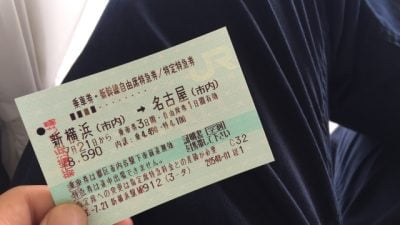Taking a train in Japan may seem straightforward, but understanding the Shinkansen ticket system is essential for a smooth and hassle-free travel experience. You might wonder why sometimes you need to purchase additional tickets. In this blog post, we will delve into the reasons behind the need for supplementary tickets when riding trains in Japan.
The Shinkansen Ticket System Explained: Regular and Express Tickets
When purchasing a ticket for the Japan Shinkansen (bullet train), you may receive two separate tickets. If you take a closer look, one ticket will be labeled “乗車券” (jōshaken), while the other will say “新幹線特急券” (shinkansen tokkyūken). But what exactly are these two tickets, and how do they differ?
To put it simply, the “乗車券” (jōshaken) represents the basic fare, while the “新幹線特急券” (shinkansen tokkyūken) covers the additional cost for riding the Shinkansen.
In other words, when boarding the Shinkansen, you need to pay two types of fares: the basic fare and the special fare for the Shinkansen.
Japan Pocket Wifi Rental
UNLIMTED DATA SIM CARD
Japan Travel Prepaid SIM card

Similar to regular trains, the basic fare for riding the Shinkansen varies depending on the distance traveled. This is known as the basic fare. However, unlike regular trains, the Shinkansen offers significantly higher speeds and various onboard services. For these additional features, an extra fee needs to be paid.
To summarize:
- 乗車券 (jōshaken) = Basic fare
- 特急券 (tokkyūken) = Additional fare for high-speed travel and extra services on the Shinkansen
Learn more about the JR East: 特急券 (tokkyūken).
During the Shinkansen journey, ticket inspections take place, and if a passenger is found without either the jōshaken or the shinkansen tokkyūken, they may be required to purchase a ticket onboard.
Other trains that require the purchase of an express ticket include the high-speed Skyliner connecting Narita Airport and Tokyo, the Fuji Excursion Train & Fuji View Express No. 1 for Mount Fuji, and the “Odoriko” train to Izu and Atami. Many trains offer combined sales of express tickets and reserved seat tickets. Generally, except for the Shinkansen, most trains that require an express ticket allow payment of the jōshaken fare using transportation IC cards like Suica. However, an additional express ticket is still required. Therefore, it is recommended to opt for purchasing tickets directly rather than relying on IC cards like Suica, as it is quicker and more convenient.
You may want to read: Japan Shinkansen Ticket Purchase & Riding Guide – A Must-Read for First-Time Visitors.
Passing through Ticket Gates: Important Points to Note

At many stations, the ticket gate for the Shinkansen is often located within the JR ticket gate area. This means that you need to pass through the JR ticket gate first and then proceed to the Shinkansen ticket gate. Alternatively, if you first take a regular JR train and then transfer to the Shinkansen at a different station, you will need to pass through the JR ticket gate at the boarding station and the Shinkansen ticket gate at the transfer station. So, how should you use your two tickets in this situation?
The method is actually quite simple. Regardless of the situation, when passing through the JR ticket gate, insert the “乗車券” (jōshaken) into the automated ticket checker.
When you reach the dedicated Shinkansen ticket gate, you need to overlap the “乗車券” (jōshaken) and “新幹線特急券” (shinkansen tokkyūken) and insert them together into the ticket gate machine, following Japan’s fare system.

Sometimes, you may have a single ticket that combines both the “乗車券” (jōshaken) and “新幹線特急券” (shinkansen tokkyūken). In this case, regardless of which ticket gate you encounter, simply insert this ticket into the ticket gate machine.
The Necessity of Two Tickets When Riding the Shinkansen or High-Speed Trains
It’s often seen on various social media platforms that foreign tourists come to Japan, purchase only “乘車券” (jōshaken) or regular tickets from the automated ticket machines, but are stopped at the ticket gates or even required to purchase additional tickets onboard.
In fact, in many countries outside of Japan, long-distance train tickets usually cover both the fare and any additional express or service fees. Therefore, many tourists who visit Japan are initially unfamiliar with the two-ticket system.
However, as the saying goes, “When in Rome, do as the Romans do.” It means adapting to local customs and practices.

When riding the Shinkansen or other high-speed trains in Japan, it’s important to keep the following points in mind:
- When purchasing tickets, the “乗車券” (jōshaken) and “特急券” (tokkyūken) are purchased separately.
- The “乗車券” (jōshaken) covers the basic fare from the departure station to the destination.
- The “特急券” (tokkyūken) is an additional fee required for riding the Shinkansen or limited express trains.
- On the Shinkansen, tickets need to be checked to ensure that you have valid “乗車券” (jōshaken) and “特急券” (tokkyūken) in your possession.
Japan Pocket Wifi Rental
UNLIMTED DATA SIM CARD
Japan Travel Prepaid SIM card
